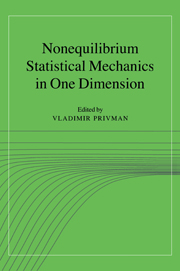Book contents
- Frontmatter
- Contents
- Contributors
- Preface
- Part I Reaction-Diffusion Systems and Models of Catalysis
- Part II Kinetic Ising Models
- 4 Kinetic Ising models with competing dynamics: mappings, correlations, steady states, and phase transitions
- 5 Glauber dynamics of the Ising model
- 6 1D kinetic Ising models at low temperatures—critical dynamics, domain growth, and freezing
- Part III Ordering, Coagulation, Phase Separation
- Part IV Random Adsorption and Relaxation Processes
- Part V Fluctuations in Particle and Surface Systems
- Part VI Diffusion and Transport in One Dimension
- Part VII Experimental Results
- Index
- Abbreviations
4 - Kinetic Ising models with competing dynamics: mappings, correlations, steady states, and phase transitions
Published online by Cambridge University Press: 18 December 2009
- Frontmatter
- Contents
- Contributors
- Preface
- Part I Reaction-Diffusion Systems and Models of Catalysis
- Part II Kinetic Ising Models
- 4 Kinetic Ising models with competing dynamics: mappings, correlations, steady states, and phase transitions
- 5 Glauber dynamics of the Ising model
- 6 1D kinetic Ising models at low temperatures—critical dynamics, domain growth, and freezing
- Part III Ordering, Coagulation, Phase Separation
- Part IV Random Adsorption and Relaxation Processes
- Part V Fluctuations in Particle and Surface Systems
- Part VI Diffusion and Transport in One Dimension
- Part VII Experimental Results
- Index
- Abbreviations
Summary
In this chapter we give a brief review of one-dimensional (1D) kinetic Ising models that display nonequilibrium steady states. We describe how to construct such models, how to map them onto models of particle and surface dynamics, and how to derive and solve (in some cases) the equations of motion for the correlation functions. In the discussion of particular models, we focus on various problems characteristically occurring in studies of nonequilibrium systems such as the existence of phase transitions in 1D, the presence or absence of the fluctuation-dissipation theorem, and the derivation of the Langevin equations for mesoscopic degrees of freedom.
Introduction
The Ising model is a static, equilibrium, model. Its dynamical generalization was first considered by Glauber who introduced the single-spin-flip kinetic Ising model for describing relaxation towards equilibrium. Kawasaki then constructed a spin-exchange version of spin dynamics with the aim of studying such relaxational processes in the presence of conservation of magnetization. Other conservation laws were introduced soon afterwards by Kadanoff and Swift and thus the industry of kinetic Ising models wTas born.
The value of these models became apparent towards the end of the 1960s and the beginning of the 1970s when ideas of universality in static and dynamic critical phenomena emerged. Kinetic Ising models were simple enough to allow extensive analytical (series-expansion) and numerical (Monte Carlo) work, which was instrumental in determining critical exponents and checking universality.
- Type
- Chapter
- Information
- Nonequilibrium Statistical Mechanics in One Dimension , pp. 73 - 92Publisher: Cambridge University PressPrint publication year: 1997
- 1
- Cited by



